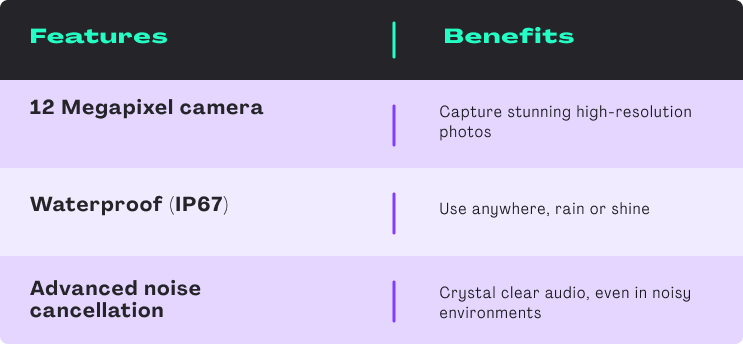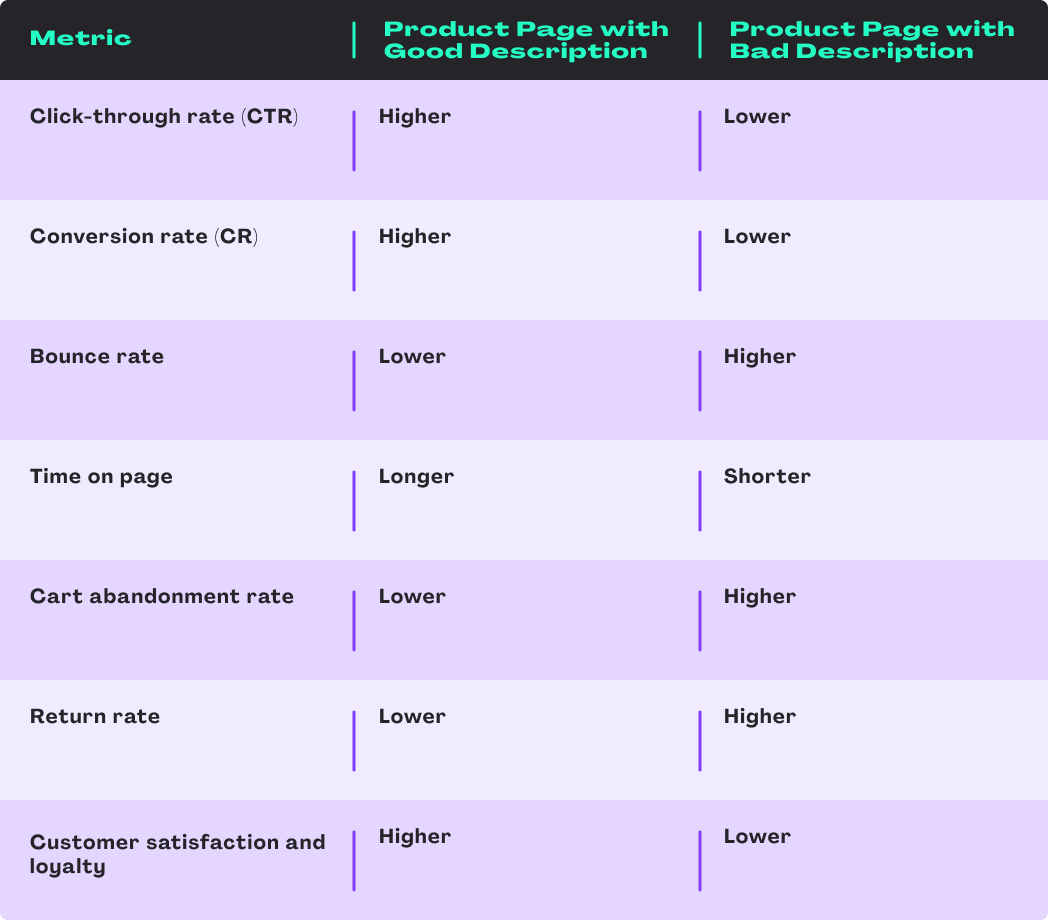At the time a potential buyer lands on your online store, intrigued by your product's images, but unsure if it's the right fit for their needs, your product description is what will make all the difference.
Humans love stories, and perhaps that’s why effective product descriptions have the remarkable ability to bridge the gap between a curious bystander and a confident purchaser. For their ability to do so, product descriptions are the unsung heroes of online retail. They are the core tool to convey the essence of your product, address customer concerns, and ignite desire — all through the artful arrangement of words.
In this article we’ll share some strategies for writing product descriptions that will convince customers to buy your products and keep returning for more. We’ll look at how to persuade your customers using language as well as the best techniques for search engine optimization.

Understanding your customers holistically
In the realm of product descriptions, knowledge is power and that power begins with a deep understanding of your target audience. You will need to try and understand a lot about your customers. Therefore, catering to their needs, preferences and pain points should lead the way to successful product descriptions.
Why you need to understand who you’re talking to
Before writing a single word, take a moment to envision the people who will be reading your product descriptions. Are they tech-savvy millennials looking for the latest gadgets, or are they in fact parents looking for practical solutions to everyday challenges? Understanding who your audience is, where they’re based as well as additional information such as their age, gender and various preferences will provide the foundation for crafting relevant and engaging descriptions.
Empathy and emotional connection
Besides knowing the general demographics of your audience, it’s useful to try and cater to their emotional lives too. If your product descriptions can demonstrate empathy you’ll be able to create an emotional connection to potential buyers. When they feel valued and understood, they’ll be more likely to buy your products and become return customers.
Aligning tone and style
The tone and style of your product descriptions should mirror the personality of your target audience and your brand. Whether it's casual and conversational or formal and informative, finding the right voice and using it consistently will help build rapport and trust with your customers. If it helps, imagine this: your product descriptions are the only place your customers are hearing you “speak”
Crafting compelling descriptions that capture the essence of your product
An effective product description isn’t just a list of features; it’s a persuasive narrative that highlights the unique selling points of your product. It showcases how it would solve your customers' problems or fulfil their desires.
Understanding the difference: features vs. benefits
Product features are the specific attributes and functionalities of your offering, while benefits are the positive outcomes and advantages that customers gain from those features.
Example 1: New phone
Feature: 12 megapixel camera
Benefit: Captures stunning high-resolution photos
Example 2: New sofa
Feature: Water resistant
Benefit: Perfect for outdoors, low maintenance
Showcasing the benefits that matter
Features are important to understand what a product might offer, but it is the benefits that will resonate with customers. Try and focus on the benefits that fulfil your customers’ desires or address their pain points. To get a clearer picture of your audience you might consider some market research – perhaps through surveys, analysing customer feedback or understanding your competitors better.
Using a features-benefits chart
A features-benefits chart can be a valuable tool in organising and visualising the information you want to highlight in your product descriptions. Create a table with two columns, one for features and the other for corresponding benefits. This chart can serve as a reference point while crafting your descriptions and ensure you cover all the essential aspects. Here’s an example of a features-benefits table:

Telling a story with benefits
With your benefits laid out you can now weave them into a compelling narrative. Instead of simply listing all the benefits your product offers, tell a story about how your products would improve or make a difference in the lives of your customers.
Addressing objections and concerns
Anticipate potential objections or concerns your customers might have and address them in your product descriptions. Reassure them that your product is the solution they've been looking for and offer reasons to overcome any doubts they might have.
By skillfully emphasising the key features and benefits, you can create product descriptions that hook your audience, build trust and ultimately drive conversions. We’ll look at the power of persuasive language and its impact on the effectiveness of your product descriptions next.
Harnessing the power of words to drive conversions
When reading a product description, a potential buyer can make their decision whether to buy a product or not, depending on how convincing or interesting the description is. Persuasive language has the power to captivate, evoke emotions and motivate your audience to take action. Next, we'll explore the art of using persuasive language to elevate your product descriptions and create a compelling call to action (CTA).
Engage the senses
Appeal to your customers' senses by using descriptive and sensory language in your product descriptions. Sensory language can create a more immersive experience for your readers, making your product come alive in their minds. Your product description should outline how the product looks, feels and functions in a real-life situation.
Example:
"Indulge in the velvety-smooth texture of our premium dark chocolate, melting blissfully on your taste buds with every irresistible bite."
Evoke emotions
Tap into the emotions of your audience by using emotionally charged language. Make your customers feel excited, inspired, or even relieved when reading about your product. This can create a powerful connection, fostering a sense of trust and loyalty. The aim is to get your audience to feel something positive about your product.
Example:
"Discover the confidence to take on any adventure with our rugged and reliable backpack, engineered to carry your dreams as you conquer the world."
Utilise power words
Power words can command attention and evoke a strong response, so you should consider using these in your product description. Power words can instil a sense of urgency or importance, encouraging customers to act quickly and not miss out on your unique offer.
Create a call to action
End your product descriptions with a clear and compelling call to action (CTA). Encourage your customers to take the next step, whether it's making a purchase, exploring more product details or signing up for updates.
A/B testing for optimization
Experiment with different variations of your product descriptions using A/B testing. This method allows you to assess which language resonates best with your audience and drives higher conversions. Continuously refining your descriptions based on data-driven insights will lead to better results over time.

Enhancing clarity and user experience in your product descriptions
As we’ve just described, persuasive language is vital for captivating your audience.The way you present your product descriptions will impact how effectively they are understood. Now we’ll take a look at the importance of formatting and readability to ensure that your descriptions are scannable, engaging and easily comprehensible for your customers.
Embrace scannability
Customers often skim through product descriptions to quickly find the information they need. Lean into this rather than resisting it! Make your descriptions scannable by breaking up the text into shorter paragraphs and using bullet points or lists to highlight key features and benefits. This approach allows your audience to grasp essential information at a glance.
Utilise informative subheadings
Employ descriptive subheadings to categorise different sections within your product descriptions. Informative subheadings act as signposts, guiding readers to relevant details and making it easier for them to find specific information quickly.
Prioritise readability
Choose a legible font style and size that enhances readability. Avoid overly decorative fonts that may distract from the content. Also, maintain enough line spacing and ensure there is enough white space around the text to prevent the description from looking cluttered.
Use high-quality images
Complement your product descriptions with high-quality images that visually represent the product. Pictures provide customers with a clear understanding of the item's appearance and features. When combined with concise and well-structured descriptions, images enhance the overall user experience.
Mobile-friendly descriptions
More and more people use mobile devices for online shopping, so ensure that your product descriptions are optimised for mobile viewing. Test how they appear on different mobile devices, like tablets and smartphones, to guarantee that they retain their clarity and readability.
Incorporate social proof
Integrate snippets of customer reviews or testimonials into your product descriptions. Social proof can reinforce the credibility of your products and contribute to the trust customers place in your brand.
Highlight key information
Place the most crucial information, such as pricing, product specifications and unique selling points, at the beginning of the description. This approach ensures that even readers who skim the content can quickly grasp the main details.
Maintain consistency
Ensure consistency between your product images and the descriptions to avoid confusion or disappointment for your customers. The product description should accurately reflect the item's appearance, features and benefits.
If you follow these points you’ll be able to enhance your user experience and encourage potential customers to not only stay on your site, but also shop and become return customers.

Increasing visibility and reaching your target audience
In the vast landscape of e-commerce, having a captivating product description alone is not enough. If you want to make sure that your online shop reaches a wider audience, you’ll need to optimise your descriptions so that your store and offerings are easy to find via search engines. Let’s take a look at the significance of search engine optimization (SEO) and how you can implement it to boost your product visibility and attract potential customers.

Identify relevant keywords
Begin your SEO journey by researching relevant keywords that potential customers might use when searching for products like yours. Use keyword research tools to discover popular search terms and incorporate them naturally into your product descriptions.
Focus on long-tail keywords
While popular short-tail keywords may have high search volumes, they also face intense competition. Instead, target long-tail keywords, which are more specific and cater to niche searches. Long-tail keywords are often less competitive, giving your product descriptions a better chance of ranking higher in search results.
Example of a long-tail keyword: "Organic gluten-free vegan protein powder for weight loss"
Explanation:
In this example, the long-tail keyword is "Organic gluten-free vegan protein powder for weight loss." Let's break down why this long-tail keyword is more effective than a short-tail version.
Specificity: The long-tail keyword addresses a precise target audience – people looking for protein powder with specific dietary requirements (organic, gluten-free, vegan) serving a particular purpose (weight loss).
Less competition: Long-tail keywords typically have lower search volumes but face less competition compared to short-tail keywords. While a broader term like "protein powder" might have high search volume, it also attracts many competitors, making it challenging to rank well in search results. By focusing on a specific long-tail keyword, you have a better chance of ranking higher and attracting a more targeted audience.
Higher relevance: Since the long-tail keyword includes specific attributes related to organic, gluten-free, vegan, and weight loss, it directly aligns with what potential customers are looking for. As a result, the chances of attracting users who are genuinely interested in your product are significantly increased.
Better conversion potential: When users search for such specific terms, they are likely to be closer to the purchasing decision. They know what they want, and if your product matches their needs, they are more likely to buy your product.
Using the long-tail keyword "Organic gluten-free vegan protein powder for weight loss" allows you to target a niche audience with specific preferences, increases the relevance of your product description to users' search intent, and improves your chances of driving conversions. It's a strategic choice that optimises your product description for search engine visibility and customer engagement.
Implement keywords strategically
Integrate your chosen keywords into the product title, description, subheadings and meta description. However, avoid keyword stuffing, as it can harm the readability and flow of your descriptions. This means that while you should try and get many keywords into your text, you need to make sure that all your descriptions still come across as authentic,
Compelling meta descriptions
Meta descriptions (the short snippets displayed in search engine results) play a crucial role in getting users to click on your product page. Make sure to craft persuasive meta descriptions that accurately summarise the product's value and uniqueness, encouraging users to want to learn more.
Examples:
Compelling meta description: "Discover the secret to effortless weight loss with our organic gluten-free vegan protein powder. Fuel your body with natural goodness for a healthier you. Try it today!"
Compelling meta description is concise, engaging and highlights the key benefits of the product. It immediately captures the audience's attention by promising an "effortless weight loss" solution. The use of terms like "organic," "gluten-free," and "vegan" resonates with health-conscious individuals seeking specific dietary options. The call to action, "Try it today," encourages users to click on the link and explore the product further. Overall, this meta description entices potential customers with its promise of a healthier lifestyle through the product.
Unconvincing meta description: "Best protein powder available. Buy now!"
Unconvincing meta descriptions are vague and lack compelling information. While this example states that the product is the "best protein powder available," it fails to explain why it's the best or what benefits it offers. The phrase "Buy now" is a weak call to action that doesn’t provide any incentive for users to click on the link. This meta description misses the opportunity to engage potential customers and leaves them uncertain about the product's unique selling points. As a result, it may not attract as many clicks or conversions compared to a more persuasive and informative meta description.
A compelling meta description should be informative, engaging, and provide a clear value proposition to entice users to click on the link. It should highlight the product's key benefits, use persuasive language, and include a strong call to action to prompt users to take the desired action, such as visiting the product page or making a purchase.

Optimise for rich snippets
Rich snippets are enhanced search results that display additional information beyond the standard title and description. By structuring your product descriptions with schema markup and product attributes, you increase the likelihood of your listings appearing as rich snippets, which can boost click-through rates.
To optimise for rich snippets:
- Use structured data markup (schema.org) on product pages to highlight key information
- Clearly define product attributes in HTML code, like titles, descriptions, prices and images
- Ensure valid HTML and CSS for proper indexing
- Optimise for mobile responsiveness
- Include high-quality images with relevant alt tags
- Follow Google's guidelines for accuracy and transparency
Make sure to use alt tags for images
Search engines can't interpret images, so use descriptive alt tags for your product images. This practice not only enhances accessibility but also provides search engines with relevant information, improving your product page's chances of being ranked higher.
Encourage customer reviews
Genuine customer reviews not only build trust with potential buyers but also contribute to SEO. Positive reviews can lead to higher click-through rates, and user-generated content adds valuable keywords and fresh content to your product pages.
Monitor performance and make changes accordingly
Keep track of your product page's performance and SEO efforts using analytical tools. Monitor key metrics like organic traffic, click-through rates, and conversion rates. Based on the data, refine your product descriptions, keywords, and SEO strategies for continuous improvement.
By optimising your product descriptions for search engines, you increase their visibility, attract more potential customers, and position your business for sustainable growth.

Building trust and driving conversions
Creating persuasive product descriptions is essential, but incorporating customer reviews and trust elements directly onto your product pages can take your marketing efforts to the next level. In this section, we'll explore the best practices for utilising customer reviews and trust elements to enhance credibility, build trust and increase conversions.
Showcase genuine customer reviews
Nothing will sell your products better than other people who love it. Place genuine customer reviews prominently on your product pages. These reviews offer valuable social proof and provide potential customers with insights into others' experiences with the product. Implement a review system that allows customers to leave detailed feedback and ratings, ensuring credibility and transparency.
Utilise review snippets
Highlight snippets of the most compelling customer reviews directly beneath the product description. These snippets should focus on the product's standout features and the benefits customers have experienced. Eye-catching quotes and star ratings can quickly capture the attention of visitors.
Display trust badges and certifications
Feature trust badges, certifications, and awards that your product has received. These may include security seals, quality certifications, or industry awards. Trust badges instantly convey a sense of reliability and professionalism, reassuring customers that their transactions are secure.
Showcase user-generated content
Incorporate user-generated content, such as images or videos, showcasing real customers using your product. This approach not only strengthens the credibility of your product but also encourages potential buyers to envision themselves using it in their own lives.
Highlight influencer endorsements
If your product has been endorsed by influencers or experts in your industry, make sure to display these endorsements on the product page. Influencer endorsements add authority to your brand and can significantly impact purchasing decisions.
Implement a Q&A section
Include a Q&A section on your product page, allowing potential customers to ask questions about the product. Respond promptly to inquiries to demonstrate excellent customer service and attentiveness.
Create a customer rating summary
At the top of the product page, present a customer rating summary based on all the reviews received. This summary should showcase the overall rating and provide a quick visual representation of the product's popularity and quality.
The transformative power of effective product descriptions
As a fun example, let's look at the contrasting outcomes between having a well-crafted product description and an average one, supported by examples. We'll also explore how a compelling product description can profoundly influence performance metrics, with the aid of tables, charts, and real-world scenarios.
Well-crafted product description:
A well-crafted product description serves as a compelling sales pitch that captivates potential customers. It showcases the product's benefits, evokes emotions, and builds trust, ultimately leading to increased conversions and customer satisfaction.
Example: Smartwatch X
"Unleash the power of Smartwatch X, your ultimate companion for a connected lifestyle. This sleek, water-resistant timepiece blends style and functionality, empowering you to monitor your health, receive real-time notifications and track fitness goals seamlessly. With its intuitive interface and long-lasting battery life, Smartwatch X keeps you ahead in the game of life."
Average product description:
An average product description fails to engage the audience and leaves potential customers in the dark about the product's value. It lacks clarity, essential details, and persuasive language, resulting in decreased interest and potential customer loss.
Example: Smartwatch X
"Introducing Smartwatch X. It's stylish and functional, perfect for your active lifestyle."
Impact on performance metrics:
Let's have a look at how a well-prepared product description can significantly influence key performance metrics by comparing results between a product page with a good description and one with a bad description.

Key takeaways
A well-prepared product description can lead to a transformative impact on user behaviour and overall business performance. With a good description, you can expect higher CTR and CR, lower bounce rates, reduced cart abandonment, and increased customer satisfaction and loyalty. Conversely, a poor description may result in the opposite outcomes.
From this article we realise that dedicating time and effort to create effective product descriptions is a strategic investment that can significantly enhance your business's success. By understanding your audience, showcasing the product's value, and employing persuasive language, you can create a compelling narrative that drives conversions, fosters customer loyalty, and elevates your brand in the competitive market.







